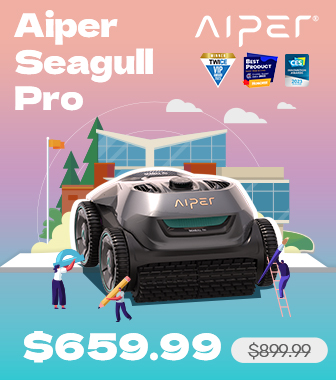There was a time—not so long ago—when well-to-do families hired butlers, gardeners, and even a young helper who, with a resigned expression and rolled-up sleeves, spent long hours fishing dead leaves out of the water. Today, the butler has wheels, the gardener is an irrigation software, and the pool boy… well, he’s a small electric automaton that patrols the floor like a methodical crab. Welcome to the age of Aiper.

The futuristic promise (half fulfilled)
Browsing the official Aiper site is like flipping through a catalog of 21st-century dreams. Spotless pools without human effort, cordless robots that glide with an almost zen-like grace, and an app that notifies you when the little robotic diver has finished its chore. The irony of modern life: we’ve built devices that can clean a pool while we remain wallowing in the clutter of our desks.
Here lies the first juicy antithesis: never before has humanity had so much power to delegate household tasks, and yet most of us are swimming in an ocean of unanswered emails and unvacuumed rooms. The pool sparkles; the rest, not so much.
An automaton dancing underwater
Aiper’s robots resemble tiny mechanical manta rays, floating over the blue bottom with deliberate, languid movements. Like a curious fish nosing through sand for food, these devices hunt down leaves, insects, and any organic intruder daring to disrupt chlorinated purity.
Watching them glide is oddly hypnotic, akin to gazing at a pendulum clock: you know it’s performing a useful task, yet it also feels like a show designed purely to soothe the modern master, that human who has no time to wield a telescopic net but plenty to watch an app flash victorious notifications.
The paradox of automated luxury
At its core, Aiper’s success unveils a deliciously absurd paradox. We’ve created robots to clean pools—goods that are themselves symbols of status. That is, we’ve invented machines to maintain pristine those mirrors of water that exist precisely to remind us we don’t need to worry about water.
Put more earthily: it’s like hiring a Swiss watchmaker to build a device that dusts our trophies for “best amateur gardener.” Technology solves a worry that only emerges once a certain level of carefree living is already achieved.
A sensible investment or a high-tech whim?
Of course, there are undeniable practical arguments: Aipers save hours of maintenance, optimize chemical use, extend filter life. They’re, as enthusiasts say, a “no brainer.” But the question lingers: do we buy them out of pragmatism or for the sweet thrill of feeling like feudal lords with robots instead of serfs?
Probably a bit of both. After all, human history is the story of inventing contraptions so others—humans, beasts, or now machines—can do what we’d rather not. From ox-driven water wheels to subaquatic cleaning automatons, there’s an invisible thread woven of creative laziness and technological ambition.
Epilogue: the robot as a mirror of our priorities
Thus, each Aiper silently traversing a pool becomes a floating metaphor for our contemporary lives: spotless on the surface, programmed for efficiency, yet often unable to scrub away the dust lurking in our deeper corners.
Perhaps that’s why we’re so mesmerized watching them work. As if, deep down, seeing a robot clean the water is a way to dream that someday, another equally silent, diligent contraption might poke through our contradictions… and finally leave our chaotic humanity gleaming.

